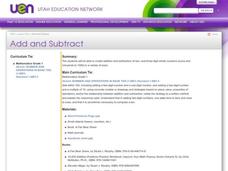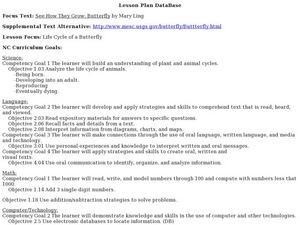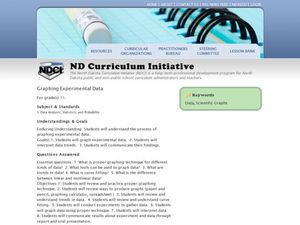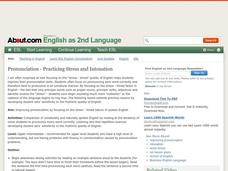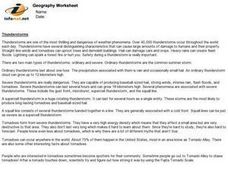Curated OER
Enzyme Activity: An Inquiry Based Approach
Using an inquiry approach to studying biochemical reactions, cooperative teams of learners investigate hypotheses about living materials that contain enzymes which break down in hydrogen peroxide. They perform experiments, practice...
Curated OER
Order of Operation
Students solve problems using the order of operation. For this algebra lesson, students factor, subtract, add and divide using the correct order to remove parentheses. They simplify expressions by combining like terms.
Curated OER
Fact Families
Students explore the relationship between addition and subtraction as they independently complete problems with fact families. Students complete fact family problems by completing a fact triangle. Additionally, students orally state a...
Curated OER
Math: Am I Prime?
Seventh graders determine the difference between prime and composite numbers. On a Website, they discover a method to identify all the prime numbers up to 100 and also complete several online activities. Once they have discussed the...
Curated OER
Miles Of Smiles
Students investigate basic mathematical properties to solve multiplication and division problems. They solve word problems that are part of the lesson. Students are required to give written or oral justification for how they solve each...
Curated OER
Long Division
Fourth graders examine and demonstrate the steps of long division. They discuss why we use long division, and observe the teacher draw an illustration of a division problem. Students then solve a variety of long division problems,...
Curated OER
Math: Heads or Tails
Seventh graders discover the difference between theoretical and experimental probabilities by designing their own problems and testing them. After conducting their own coin toss trial, they compare their results with an Internet...
Curated OER
Math: How Many Ways Can You Find the Middle?
Twelfth graders find the mean, median, and modes of stacks of Lego blocks, They search in newspapers for real life applications of them. They present oral reports on what they have learned.
Curated OER
Diversity and Adaptations of Organisms
Eighth graders discover the difference between extinct and endangered animals and discuss the reasons why this has occured. They identify threatened and endangered animals living in their local area as well.
Curated OER
Going Graph-y
Second graders listen to and dicuss the story Where the Wild Things Are. They play a pantomime game and act out various feelings so their classmates can guess. They listen for the frequency of certain words, and record their findings on...
Curated OER
Butterfly Addition: Color by Numbers
Children learning to add numbers up to 11 develop the strategy of using the larger number as the first addend and counting on from there to find a sum. They define addition and review the meaning of the plus (+) symbol. To practice, they...
Curated OER
Add and Subtract
Like the cubs in A Fair Bear to Share, your 2nd grade class will practice adding and subtracting double-digit numbers by grouping, regrouping, and sorting a collection of objects. This requires many resources, but it is well worth the...
Curated OER
Heroic Vocabulary: Using Decoding Strategies and Thesaurus
Develop the decoding skills of your middle and high schoolers. Scholars participate in a classroom activity that requires them to decode a word with a prefix and suffix. They apply the skill of breaking the word into parts of meaning as...
Curated OER
Immigration Unit
Third graders develop an appreciate for the various cultures that are present in their local community. Through reading and research, they explain how various culture came to live in their area. At the conclusion of the unit, 3rd...
Curated OER
See how They Grow: Butterfly
Students view butterflies and participate in a butterfly activity to learn needed vocabulary. In this butterfly life cycle activity, students access prior knowledge of butterflies. Students listen to a butterfly life cycle book....
Curated OER
Thematic Unit: Beginning Holocaust Studies
Fifth graders discuss concepts of diversity, culture, and prejudice, gain understanding of harm caused by prejudice, and demonstrate ability to think critically and a desire to act morally.
Curated OER
Simulation of Gene Splicing
Students use the exercise as a prelude to a "wet" lab or as a substitute for such a lab. It correlates well with colony transformation labs. This lab is recommended for students what have difficulty with the abstractions that genetic...
Curated OER
Optical Illusion
Students practice creating optical illusions as well as discerning how perception of information may change its characteristics. They distinguish between an equilateral triangle, endpoints, vertices's, and segments of triangles. The...
Curated OER
Data and Scientific Graphs
Learners conduct experiments and graph their data. In this statistics lesson, students collect data and graph it on a coordinate plane. They analyze the data looking for patterns and they discuss their findings with the class.
Curated OER
Habitats: Rainforest
Students use the internet to find reasons the rainforest is endangered and ways that affects the rest of the world. They read for information, perform experiments, locate rainforests on maps, and write about this ecosystem.
Curated OER
Mathematics In You
Students construct ratios using the hand as data. They use examples of cortical and trabecular bone found in the long bones to measure circumference, diameter, length, and weight of long bones. They perform computations using growth...
Curated OER
Pronunciation: Practicing Stress and Intonation
Learners practice their pronunciation of their words and stressing certain words when speaking. They use sentences given to them by their teacher to practice.
Curated OER
Thunderstorms
Fourth graders examine the attraction between two different charges to investigate lightning in a thunderstorm. They complete an experiment and a worksheet.
Curated OER
Enzyme Activity: An Inquiry Based Approach
Students explore biochemical reactions mediated by enzymes in an inquiry approach. They are given two questions about the types of living materials that contain the enzymes that break down hydrogen peroxide, and under what conditions the...











